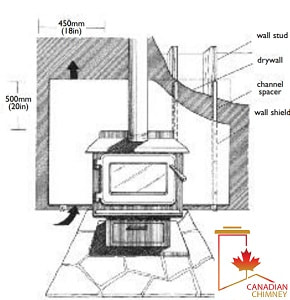Floor Pad Even though certified wood stoves wont overheat your wooden floor you still need to install a floor pad to protect the stove from live embers that might fall out of the stove. These clearances are for unlisted appliances that require 36 inches with no shielding.
 Wood Stove Safety Do It Yourself Mother Earth News
Wood Stove Safety Do It Yourself Mother Earth News
A stove with a metal jacket casing requires 900 mm 36.

Wood stove clearances. Otherwise install according to the manufacturers instructions. Clearance Requirements for Certified Stoves in Canada. The common feature of the clearance reduction rules is the air space behind the shield material.
These distances can be cut in half by using approved wall protection. Un-certified woodstove clearance distance. 60 above the stove top to the ceiling or any combustible above the heater.
We all want our wood stove installation to take up. The stove was placed into a wooden booth. Most of the double wall stove pipe allows for 6 clearance from wall combustibles and 8 from ceiling combustibles.
The clearances for un-certified stoves can be reduced safely using the rules set out below. Jotul Wood Stove Clearances to Combustibles. The clearances are large because they apply to all shapes sizes and designs of stoves that have not been tested to determine the actual clearances.
Clearances for Combustibles Clearances for an uncertified stove. The clearance for an uncertified radiant stove is 1200 mm 48 in and for a stove with a sheet metal jacket or casing the clearance is 900 mm 36 in. For the installation of any vintage wood cookstove the most recent requirements that I have say that the clearance from the stove to any combustible wall or furniture etc is 36.
Safe clearances for your model were determined using a very specific and detailed UL. Clearances for uncertified stoves. Clearance to combustible requirements for non certified radiant wood stove is 1200 mm 48.
We all want our wood stove installation to take up as little floor. Wood stoves are the most common space-heating appliances and can be installed almost anywhere in the house provided there is enough clearance and proper routing of the chimney. Clearances to Combustibles Floor Protection Alternate Floor Protection Clearance to Adjacent Combustible Materials Using a Rear Heat Shield to Reduce Clearance in Alcove lnstallations Using Wall Protectors to Reduce Clearances.
In most cases clearance violations will not cause a fire immediately. Reducing Minimum Clearances Safely. HOW FAR SHOULD A WOOD STOVE BE FROM AN UNPROTECTED WALL OR COMBUSTIBLE MATERIALThe standard clearance for appliances installed in rooms which are large in comparison to the size of the appliance is 36 inches from the top sizes back or front of the appliance.
A spark is not required to start a fire just heat fuel and oxygen. Some standards specify a 2 air space. What is a Clearance.
Many think stovepipe can run from the wood-stove right up through the ceiling and roof. A clearance is the safe distance from the stove to a combustible surface. Clearances are important because wood stoves get very hot while in operation.
This space sets up a convection flow of air as the stove is operating and prevents most of the stoves. This limitation can often be overcome by the use of special double wall interior piping or stove pipe heat shields either of which can reduce the pipe clearance to as. It is important to seek expert advice when purchasing a new stove to ensure you have the right stove size and output.
The clearance for an uncertified radiant stove is 1200 mm 48 in and for a stove. The clearance for an uncertified radiant stove is 1200 mm 48 in and for a stove. We all want our wood stove installation to take up as little floor space as possible so the reduction of minimum clearances using special shields is common.
This is not the case and can. Reducing Minimum Clearances Safely. Using a Heat Shield on a single wall stovepipe allows you to reduce the clearances from 18 to 6 to the wall and 9 to the ceiling.
The required distance between single-wall stovepipe and combustibles is 18. Combustible materials that are too close to the stove can heat up past their autoignition temperature and catch fire. Making a mistake can lead to a dangerous building fire.
Full size brick in contact with a combustible wall would allow 33 clearance reduction 24 inches and a 1 inch air space between approved shield and wall allows 66 reduction down to 12 inch minimum. Un-certified woodstove clearance distances when the stove has a sheet metal jacket or casing 36 to combustibles. Installation Clearances for Wood Stoves Clearances for an uncertified stove.
Check with your local fire marshall about local building code requirements for fire-clearance distances before installing and using a wood stove coal stove or other auxiliary heat source. Clearances can be reduced on certified and uncertified stoves by permanently mounting a sheet-metal brick stone or ceramic tile shield to the wall behind the stove. Wood stoves certified for installation in an alcove may not be reduced unless otherwise stated by the appliance manufacturer or AHJ.
Single wall chimney connector usually has a clearance of 18 from combustible walls. Examples of combustible materials include paneling wood sheet rock even fire rated and plaster lathe.
